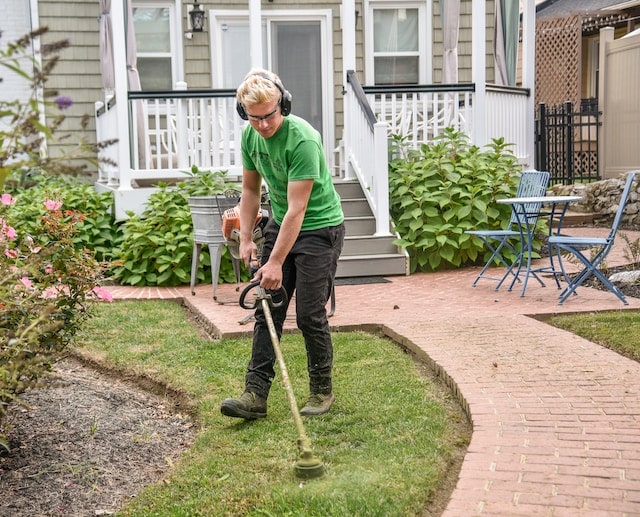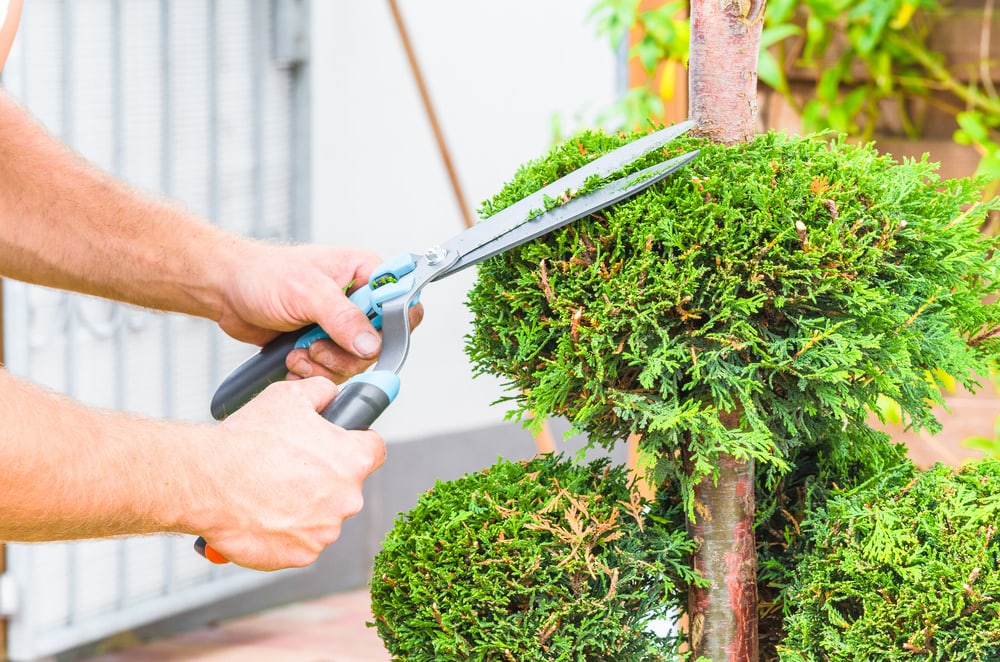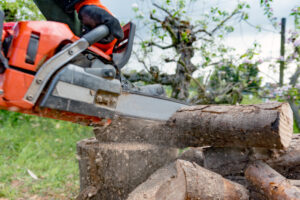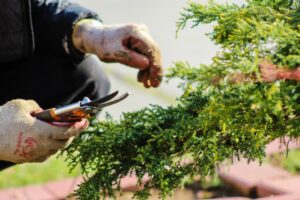If you want your landscaping to look its best at all times, the grass isn't the only item that has to be trimmed here and there on a regular basis. In addition to that, your plants require some care. We go over the proper way to prune bushes, shrubs, and hedges so that they maintain a neat appearance while still developing into robust and healthy plants.
Giving your plants the trim they so much need can be intimidating. You might not become a topiary expert, but you will definitely learn how to shear spirea, bob boxwoods, lop lilacs, and trim privet. You might not become a topiary expert, but you will learn these skills.
You are not the only one who recoils in horror at the prospect of slicing into what seems to be a plant that is living its best possible life. However, even homeowners who are aware of the advantages of pruning, such as improved health, an increase in positive behaviours, and larger flowers, frequently need help determining when and how to make the necessary cuts. They are afraid that they will remove next year's flowers, slow the plant's growth, or even kill it if they make the wrong cuts. When you finally get a handle on how plants react to being pruned, you'll realise just how many issues a single cut in the right spot may resolve.
A dense and bushy appearance is achieved by properly trimming a hedge. Not only will it restrict the limits of your garden, but it will also act as a beautiful component of the overall landscape design that you have created. Continue reading to learn how to properly plant a hedge and care for it so that it develops into a robust and robustly healthy plant.
Bushes & Hedges: What's the Difference?
There are few distinctions to be made between bushes and hedges, despite the fact that a hedge can be simply recognised as a row of bushes, shrubs, or trees. Many people in the horticultural industry believe that the only significant distinction is in the use of regional terminology.
Plants classified as bushes are typically deciduous and mature to a height of fewer than 15 feet. In most cases, there is more least one perennial stem present, as well as many branches with a diameter of fewer than 3 inches. Although there are always going to be exceptions to this general rule, using it as a starting point for identifying the plants in your landscape is an excellent idea.
What are Bushes?
Some people consider bushes to be the more unruly form of shrubs, even though, properly speaking, shrubs and bushes are the same plants. Bushes are low-maintenance plants that, ideally, require very little, if any, trimming.
Azaleas and Rhododendrons
When not pruned, the greatest group of bushes achieve their optimal level of growth. In point of fact, the greater the amount of pruning you do, the fewer blossoms they will produce.
Rosemary
After rapidly reaching a height of three feet, there is no need to prune the plant in order to keep its shape and size. This evergreen woody plant is frequently referred to as a herb since it is so simple to cultivate and requires very little water.
Dwarf Japanese Cedar (and other compact conifers)
Keep a low, mound-like shape with no additional upkeep required.
Shrub Dogwoods
Because of their rustic appearance, they are purposefully planted. They are frequently utilised in naturalised gardens, and the brightly coloured winter stems they produce give gardens a sense of beauty throughout the entire year.
Roses
They differ from the rest of this category in that they frequently need to have their branches pruned. It is common to practise referring to rose plants as bushes, yet no one ever says "rose shrubs."
What are Hedges?
A line of shrubs or trees, either left natural or manicured, that are placed to form a natural fence is called a hedge. These completely natural borders can generate shade, preserve privacy, and demarcate territory. The formation of a hedge can be accomplished in some different ways, from using low-maintenance, informal bushes to using densely clipped shrubs to create a formal hedge in a more conventional garden environment.
Emerald Arborvitae
It is a versatile and perpetually available hedging strategy. It can reach a height of up to 15 feet on its own, but it can be pruned to reach any size.
Rose of Sharon
It is a flowering bush that may be grown with little effort. However, your landscaping will benefit from the addition of some softness provided by this deciduous shrub, which is typically not pruned.
North Privet
It is one of the alternatives with the quickest growth rate, reaching a height of up to 3 feet annually. This shrub is only considered to be semi-evergreen, but it grows dense and compact, making it ideal for creating the most attractive trimmed hedges. In addition, regular cutting helps it maintain its pristine appearance.
Glossy Abelia
Your yard will be filled with butterflies thanks to the small trumpet-shaped flowers it produces. You can prune it to produce a modest hedge, but if you leave it untrimmed, it will grow into an elegant arching hedge that is anywhere from three to six feet tall.
Japanese Euonymus
Rapidly attains a height of 15 feet but, with proper maintenance and pruning, can be maintained at a more manageable height. It comes in a range of foliage colours, some of which feature variegated leaves with white, gold, or cream streaks running through them.
Why Prune?
The pruning process serves to both slow growth and stimulate new bud development in the plant. When a plant is trimmed, the buds on the plant are exposed to more sunlight, which encourages new development and ultimately results in larger leaves, blossoms, and fruit on the plant.
There are many different reasons to perform pruning. The first step is to give the plant some form in order to improve its appearance. Then, you can prune it to stimulate further blossoming of the plant.
It may be necessary to prune a hedge to maintain its attractive, formal appearance, and it may also be necessary to prune a shrub in order to prevent it from obstructing a window or shading out other neighbouring plants. It is also possible for it to induce new growth in an older bush that is not growing particularly well.
Cuts you can make any time of year.
A good number of homeowners find doing their own trimming to be intimidating, yet there are a few cuts that simply need to be corrected. Keep in mind that something is either dead, injured, or ill. You are free to prune your trees at any time of the year if you find diseased or damaged branches, dead branches, or branches that show evidence of having been struck by a storm.

Before you Start to Trim
Before you begin chopping away at branches or trimming the tops of your boxwoods, there are some things you need to understand and carry out first.
- First, take stock of your resources. Gardeners suggest picking up an Extension publication on the specific kind of bush, hedge, or shrub in order to determine the right pruning routine. This can be done by looking up information online.
- Second, be certain that you have a strategy for landscaping. What do you see the finished product of the landscape to be like?
- Third, assemble all of your pruning tools and make sure they are sharp.
- In conclusion, begin by cutting away any limbs that are unhealthy or have died, and then move on to any branches that are crossing and rubbing against one another. Additionally, try to trim as many of the branches as possible that are growing back towards the centre of the tree or shrub. These branches will ultimately cross other branches, which will cause them to rub against one another.
Tools for the job
For the purpose of pruning and trimming plants and trees, a pair of bypass loppers with black handles are utilised.
As the three Ds can be cut at any time of the year, you should ensure that your instruments are always in working order. The most crucial thing you can do to guarantee that your trimming is successful is to ensure that your pruning tools are sharp and clean.
You can file your blades yourself or take them to a shop to get them done. When you are done clipping sick branches or moving between trees, clean your trimming tools with rubbing alcohol or a bleach solution that has been diluted with water.
Standard implements:
- Loppers
- Bypass pruning shears
- Pruning saw
How to Trim Bushes
Depending on the species, bushes can be either single- or multi-branched plants. Because the conditions in your region and during their growing season can cause them to become unruly, it is in your best interest to become familiar with their growth patterns and to maintain control over them.
A gas-powered or electric hedge trimmer is likely your best alternative if you have dense, leafy shrubs that need to be trimmed. This will allow you to keep the bushes tidy and clipped while maintaining their dense cover of foliage. However, in order to maintain the bushes' health and attractiveness over the long term, it is necessary to do multiple types of trims.
- The term "thinning" refers to removing unwanted growth by cutting entire branches off at their point of origin. This results in a more open plant. Because of this openness, more sunshine and air can enter the core of the bush, leading to more internal development (leaves) along the stem and a reduction in disease (due to increased airflow). Conversely, cutting vegetation too deeply will simply result in abundant new growth.
- In contrast to a thinning cut, a heading cut merely removes a little section of a branch all the way back to a bud. This might cause undesired witches' broom effects in certain plants due to the stimulation of excessive growth that it brings about. Heading cuts are useful when you want to minimise the number of buds on a branch to promote more robust development (fruit or flowers) from the buds left on the branch. Heading cuts can be performed by cutting the branch at its nodes.
- Shearing shapes a bush by making incisions in it without paying attention to where the buds are located. (Hedge trimmers, either electric or gas-powered, are the tools of choice for shearing.) The treatment is typically applied to plants that have multiple buds close to one another. The cuts will, in any case, end up near a bud and will encourage robust new growth; however, this may restrict flowering.
Best Time to Trim Bushes
According to the Michigan State University Extension, pruning bushes should be done in the late winter or early spring. This should be done before the new growth for the year begins. However, the inappropriate time to prune is in the middle of summer, which is after the new growth has established itself.
From March to July, you can trim your bushes to give them the form you want, but most gardeners recommend stopping most of your pruning by August at the latest. After being shaped, the weak new growth has a greater risk of being damaged by the winter that is to come. However, there are some notable outliers. Some plants, particularly native species, can have their pruning done in the fall.
Flowering Bushes
The question of whether or not a plant flower is an important consideration. He explains that while some flowering bushes would appear better when pruned before blossoming, others, such as lilacs, will look better when allowed to flower naturally and then pruned thereafter. Find outside when you plant flowers to determine the appropriate time to prune them.
Those shrubs that bloom in the spring produce their flower buds on the growth from the previous year (old wood). Therefore, your plant is deemed to have spring flowering characteristics if it blooms prior to the 30th of June.
Bushes bloom from their flower buds in the summer on the new growth that occurred in the current year's spring; therefore, it(new wood). Therefore, it is regarded to be summer flowering if your plant starts producing blooms after the month of June has ended.
It is important to know when a plant blooms so that you can prune flowering bushes at a period that will cause the least damage to the blooming process. Check the Internet for a guide to plants that grow in your area, or get in touch with a knowledgeable person in your community, such as an Extension agent or a worker at your neighbourhood nursery.
How to trim a hedge
Building a tall hedge all the way around your property is an efficient strategy for ensuring that you have some seclusion. It will help reduce the noise from the street and give shade when the weather is particularly warm. In addition, hedgerows can be pruned and shaped in such a way as to conceal garbage cans and compost piles from plain view.
The primary function of shorter hedges that can be trimmed into various forms will be that of a decorative element. However, those who have a passion for the natural world will get a kick from seeing birds perching or breeding in their garden hedges, which also protect insects and hedgehogs.
Hedgerows, on the other hand, need to be maintained on a consistent basis if their growth is not to be allowed to become uncontrollable. When their branches have had more time to thicken and become woodier, it will be more challenging to shape them the way you want them to look. The hedge will inevitably develop holes, which will cause it to lose some of its aesthetic value.
Trimming is something that should be done only sometimes the need strikes. We recommend that the frequency and depth of pruning be carried out by the general guidelines that are provided for various types of bushes. The age of the plants is another significant factor to consider. Cutting an old hedge implies maintaining its linear shape while eliminating any dead leaves or branches.
When should a hedge be trimmed?
It is recommended that if you are going to trim a hedge for the initial time that you do so in the spring. The end of March or the beginning of April is the ideal period. The majority of plants begin their growth cycle at this time, and the climate is typically warm and bright enough to support unchecked expansion. However, before you do that, you should review the weather forecast to see if any frosts are predicted for the upcoming period. The height of the tree is cut down between 8 and 12 inches for the first cutting. Beech, hornbeam, and maple are examples of plants that should not have their branches trimmed in the early spring because they produce sap.
At least once a year, more pruning is required to be performed (ideally 2-3 times per year). The plants should be pruned back, leaving between one to twelve inches of new growth, but this varies depending on the sort of hedge you wish to produce. However, keep in mind that you should finish all the pruning before the end of August. After this date, trimming will cause new shoots to emerge, and it's possible they won't survive the first cold.

How to cut and shape a hedge
It doesn't matter what kind of hedge you have; the trimming process should always begin on one of the sides. Using string as a guide to make cuts can be a helpful way to ensure that your cuts stay in a straight line while also making the process of cutting much simpler. You can trim the hedge to make either a square or a semi-circular shape, though the specific form you take will depend on your kind of hedge. The latter method has many benefits, one of which is that because of the form, it enables rainwater to contact the roots of the plant more easily. After a few years have passed and you have gained further knowledge in the field, you could want to experiment with more unique shapes, such as waves or other rounded or squared ornamental features.
Remember to prune the twigs and branches in a horizontal direction. It is not appropriate to cut them on a diagonal or divide them in half. The shoots will have a difficult time growing, and there is a possibility that they could dry up, making them more susceptible to fungal infections.
It is important to always water and fertilise the plants after cutting them, as this will promote healthy growth. When planting a larger hedge, you will also need to have access to a proper garden hose. This is because young plants, particularly those planted in urban areas, need consistent access to adequate water.
Pro Advice
When dealing with a rogue evergreen branch, make sure to trim it back to the middle of the shrub, where it joins another stem. This will allow you to get rid of the problem. If you chop off the problematic section, the remaining cut stub will be visible and unpleasant to look at.
You have inherited a hedge that has been cut sloppily.
Make cuts in a strategic pattern to tidy up a shrub that has been improperly pruned. This will encourage new growth in the areas where you want it and remove damaged and weaker wood. When a cut is made in the appropriate location, at the appropriate angle, and with an instrument that is both sharp and clean, the wound will heal more quickly. Find a branch that already has a bud and position it so it is facing the desired direction for the new growth to emerge. It should be pruned at an angle of 45 degrees directly above that bud, with the lowest point of the cut being the furthest away from the bud.
If you want to avoid encouraging rot, you should leave at most a quarter of an inch of growth above the bud. Cutting at an angle that is greater than 45 degrees might create a big surface area that is sluggish to heal and invite disease. On the other hand, cutting too low can cause the bud to dry up.
The problem is that your hedge appears to be dead inside despite having lush foliage at the top.
Make thinning incisions to the plant in order to open it up. Simply cutting back the branch tips of a shrub, be it with hand pruners or electric shears, will result in thick foliage at the top of the shrub and a tangle of weak, leafless branches in the middle of the bush. When a plant is thinned, either the entire branch is cut back to the main stem or major pieces of the branch are removed back to the main stem. This allows more light and air to reach the centre of the plant and encourages healthy new growth throughout. Before moving on to the younger stems, remove the wood that is the oldest and thickest first.
Only one-third of a plant's mass should be removed each year in order to maintain its vitality and attractive appearance.
You have a problem with your hedge as it is leaning to one side.
To guide development in the appropriate path, you should make use of heading cuts. In contrast to thinning cuts, which eliminate an entire branch, heading cuts prune a branch so that it ends just above a bud from which you wish to encourage more branching. For example, if you want to accelerate growth and level out a shrub leaning to one side, you need to prune the side leaning less. This may sound paradoxical. Place the pruner so that it is positioned on the portion of the stem that you wish to eliminate, right above a bud that will grow in the direction that you desire to stimulate.
In any given cut, you should take at most one-quarter of the whole length of a stem. When dealing with shrubs that are extremely asymmetrical, it is best to employ thinning cuts to remove older wood from the side that is longer and heading cuts on the side that is shorter.
The problem is that you have an old bush that has become a twisted, woody mess.
Give the plant a thorough makeover by gradually removing the older wood over three years to make place for any new growth that may occur. Eliminate the branches closest to the core of the shrub, working from the bottom up. Aim to remove no more than one-third of the overall mass of the shrub. The subsequent growing season should see the beginning of new growth emanating from the root system. In years two and three, remove an additional third of the aged wood from the tree's foundation. It is expected that at the end of the third year, the shrub will be composed entirely of new growth that is robust.
You should only prune away a third of the shrub's branches at any one time. This ensures that the plant maintains a healthy amount of foliage so that it can produce enough food (through photosynthesis) to continue to be vigorous and quickly generate new growth.
The problem is that the bottom of your flowering evergreen hedge is overgrown with twigs.
If you want to encourage side branching on the lower part of the shrub, use your index finger and thumb to pinch off the end (or terminal) buds of new branches on rhododendron, azalea, Japanese Pieris, mountain laurels, and other broad-leaved evergreens. This will help the plant produce more side branches. In the same way that a heading cut does, manually cutting the terminal leaf bud stimulates lush side branching by signalling a dormant bud below it to wake up and start growing. This is also a method for keeping the overall size of the shrub under control.
Be careful not to remove the flower buds as you go through the process. These are the larger, plumper buds that can be found at the very tips of branches.
General Trimming and Pruning Tips
The following guidelines for trimming shrubs and hedges will help you save time and ensure that your bushes remain in good health:
- When pruning or trimming bushes, shrubs, or hedges, it is imperative to use protective eyewear and gloves at all times. It is only possible to predict when a cutting will go in the right way.
- When cutting off just the tips of shoots or limbs, it is important to remember that new development will occur in the opposite direction of the bud points that are still present.
- Remove all of the clippings to reduce the risk of disease and pests. Then, place a tarp on the ground to catch the clipped leaves and branches or rake everything up when you finish. Both options are available to you.
- A thick layer of mulch can help retain water and prevent grass and weeds from robbing nutrients from your bushes. Mulch can also assist in beautifying your garden. However, it is important to remember to leave some space between the mulch and the base of each plant.
- New growth can be stimulated by cutting back bushes and hedges. In order to promote stronger branching and richer foliage on shrubs, I like to prune them, especially while they are young.
- You might be curious about the best way to trim high hedges. Rather than attempting to keep hedges at a specific height, it is preferable to use shrubs that can grow to the desired height of the hedge.
- Hedgerows with rounded, formal shapes are better able to withstand the pressure of heavy snowfall in regions that experience it.
Summary
Trimming bushes and hedges is a rewarding activity that can transform your landscape. By following these tips and techniques, you can achieve beautifully maintained plants that enhance the overall aesthetics of your outdoor space. Remember to approach trimming with patience, care, and a clear plan to achieve the best results. If it seems to you that taking care of bushes and hedges is a very complicated thing, don't worry, our professionals will be happy to help you.
Frequently Asked Questions
Is it possible to completely remove a bush from its roots?
Indeed, this practice is known as rejuvenation trimming (aka renovation pruning). It is typically done in deciduous hedges with the goals of reviving the colour of the stems, increasing the number of blooms produced, or maintaining the desired size of the plant.
How far can you go back when trimming a hedge?
A common piece of advice from knowledgeable individuals is to prune at most one-third of the hedge in a single growing season. This is because transpiration, the process by which plants transport water up from their roots and into the rest of the plant, requires that plants have leaves.
What should I do with the branches and clippings from my hedges?
You can compost your trimmings in your own yard or have the city or town in which you live compost them for you if they provide that service.
Are there any specific techniques to follow when trimming bushes and hedges?
Yes, there are a few techniques that can help you achieve clean and attractive results when trimming bushes and hedges. Start by removing any dead or diseased branches. To maintain a natural and uniform appearance, trim along the natural shape of the plant, cutting just above a bud or a leaf node. Use long, sweeping motions to create smooth and even cuts. Step back occasionally to assess the overall shape and make adjustments as needed.
Can I use the trimmed branches for anything useful?
Trimmed branches from bushes and hedges can be put to good use in various ways. They can be used as mulch to enrich the soil in your garden beds or around the base of trees. Smaller branches can be chipped or shredded to create organic mulch. Additionally, if the branches are suitable, they can be used for crafts, such as wreath making or creating natural garden borders. However, it's important to dispose of any diseased or pest-infested branches properly to prevent the spread of pathogens.







